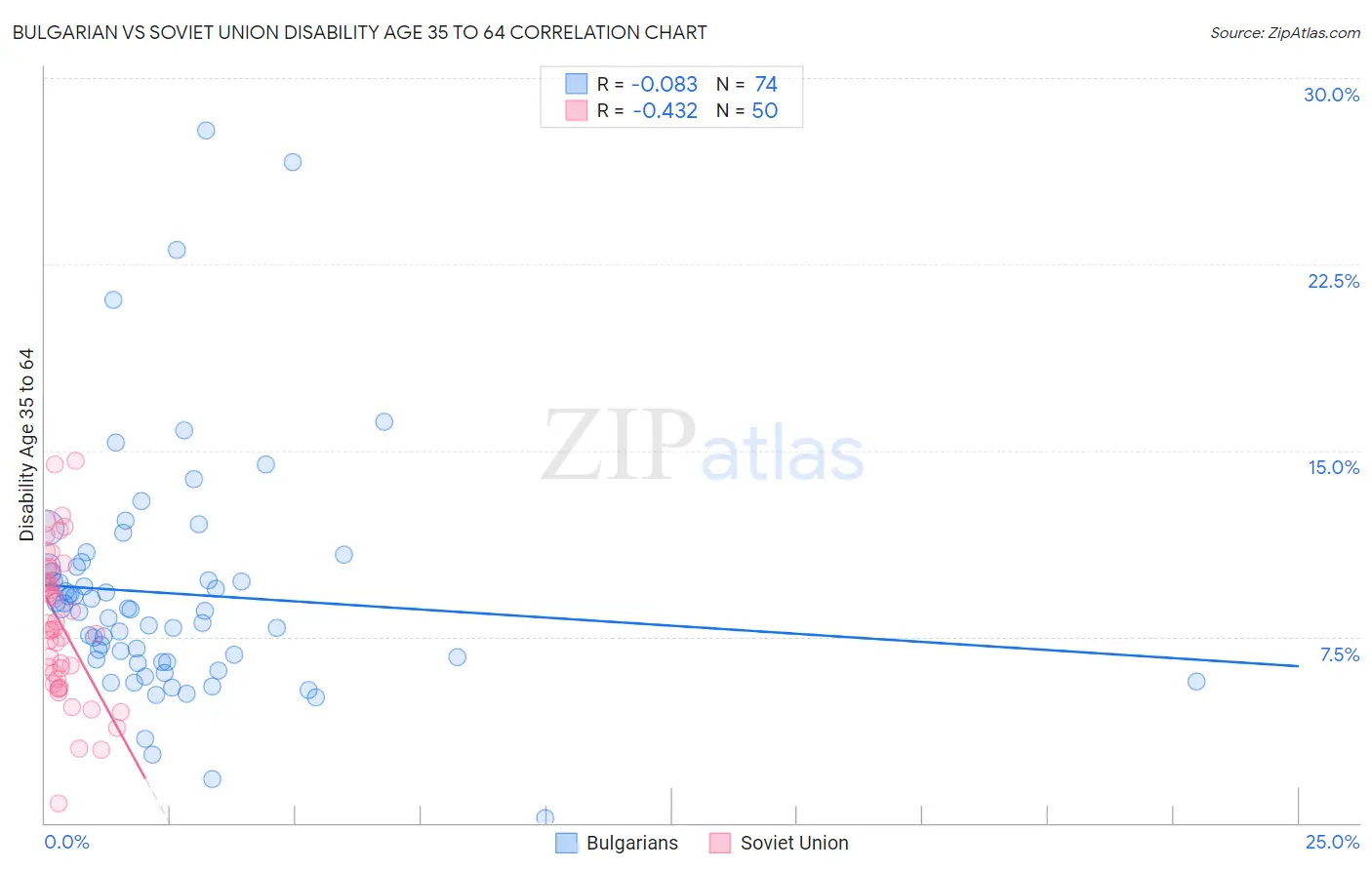Bulgarian vs Soviet Union Disability Age 35 to 64
COMPARE
Bulgarian
Soviet Union
Disability Age 35 to 64
Disability Age 35 to 64 Comparison
Bulgarians
Soviet Union
9.7%
DISABILITY AGE 35 TO 64
99.9/ 100
METRIC RATING
35th/ 347
METRIC RANK
9.2%
DISABILITY AGE 35 TO 64
100.0/ 100
METRIC RATING
18th/ 347
METRIC RANK
Bulgarian vs Soviet Union Disability Age 35 to 64 Correlation Chart
The statistical analysis conducted on geographies consisting of 205,563,326 people shows a slight negative correlation between the proportion of Bulgarians and percentage of population with a disability between the ages 34 and 64 in the United States with a correlation coefficient (R) of -0.083 and weighted average of 9.7%. Similarly, the statistical analysis conducted on geographies consisting of 43,509,630 people shows a moderate negative correlation between the proportion of Soviet Union and percentage of population with a disability between the ages 34 and 64 in the United States with a correlation coefficient (R) of -0.432 and weighted average of 9.2%, a difference of 4.6%.

Disability Age 35 to 64 Correlation Summary
| Measurement | Bulgarian | Soviet Union |
| Minimum | 0.21% | 0.79% |
| Maximum | 27.9% | 14.6% |
| Range | 27.7% | 13.8% |
| Mean | 9.2% | 8.0% |
| Median | 8.6% | 7.8% |
| Interquartile 25% (IQ1) | 6.5% | 5.8% |
| Interquartile 75% (IQ3) | 10.3% | 10.1% |
| Interquartile Range (IQR) | 3.8% | 4.3% |
| Standard Deviation (Sample) | 4.8% | 3.0% |
| Standard Deviation (Population) | 4.8% | 2.9% |
Demographics Similar to Bulgarians and Soviet Union by Disability Age 35 to 64
In terms of disability age 35 to 64, the demographic groups most similar to Bulgarians are Immigrants from Cuba (9.7%, a difference of 0.040%), Immigrants from Australia (9.7%, a difference of 0.10%), Immigrants from Indonesia (9.7%, a difference of 0.17%), Turkish (9.7%, a difference of 0.25%), and Immigrants from Lithuania (9.6%, a difference of 0.90%). Similarly, the demographic groups most similar to Soviet Union are Immigrants from Venezuela (9.3%, a difference of 0.24%), Burmese (9.2%, a difference of 0.41%), Immigrants from Argentina (9.3%, a difference of 0.75%), Okinawan (9.4%, a difference of 1.2%), and Cypriot (9.4%, a difference of 1.2%).
| Demographics | Rating | Rank | Disability Age 35 to 64 |
| Immigrants | Korea | 100.0 /100 | #16 | Exceptional 9.0% |
| Burmese | 100.0 /100 | #17 | Exceptional 9.2% |
| Soviet Union | 100.0 /100 | #18 | Exceptional 9.2% |
| Immigrants | Venezuela | 100.0 /100 | #19 | Exceptional 9.3% |
| Immigrants | Argentina | 100.0 /100 | #20 | Exceptional 9.3% |
| Okinawans | 100.0 /100 | #21 | Exceptional 9.4% |
| Cypriots | 100.0 /100 | #22 | Exceptional 9.4% |
| Argentineans | 100.0 /100 | #23 | Exceptional 9.4% |
| Asians | 100.0 /100 | #24 | Exceptional 9.4% |
| Venezuelans | 100.0 /100 | #25 | Exceptional 9.4% |
| Immigrants | Sri Lanka | 100.0 /100 | #26 | Exceptional 9.5% |
| Immigrants | Asia | 100.0 /100 | #27 | Exceptional 9.5% |
| Immigrants | Pakistan | 100.0 /100 | #28 | Exceptional 9.5% |
| Immigrants | Ireland | 100.0 /100 | #29 | Exceptional 9.5% |
| Immigrants | Japan | 100.0 /100 | #30 | Exceptional 9.5% |
| Immigrants | Lithuania | 99.9 /100 | #31 | Exceptional 9.6% |
| Turks | 99.9 /100 | #32 | Exceptional 9.7% |
| Immigrants | Indonesia | 99.9 /100 | #33 | Exceptional 9.7% |
| Immigrants | Australia | 99.9 /100 | #34 | Exceptional 9.7% |
| Bulgarians | 99.9 /100 | #35 | Exceptional 9.7% |
| Immigrants | Cuba | 99.9 /100 | #36 | Exceptional 9.7% |